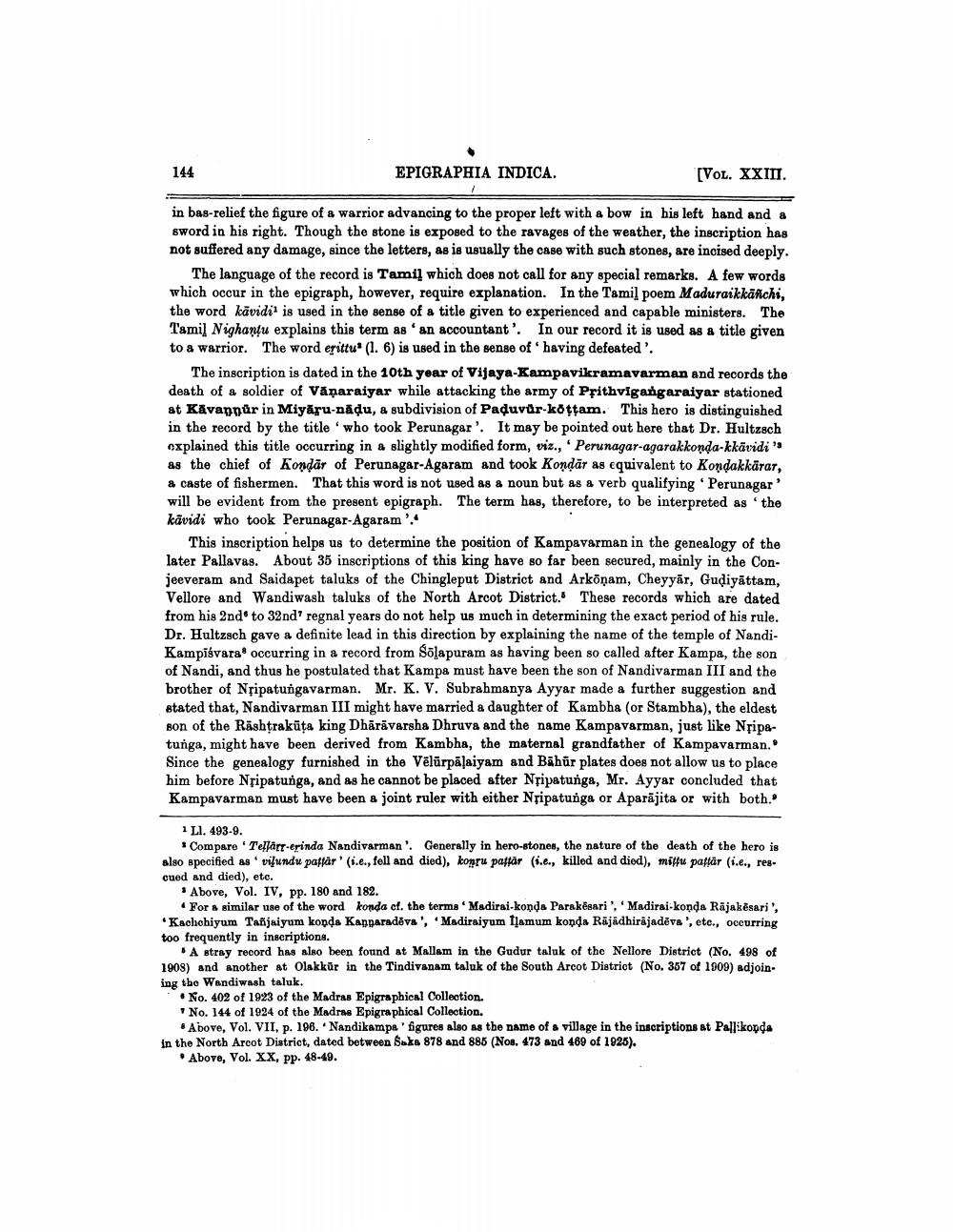________________
144
EPIGRAPHIA INDICA.
[VOL. XXIII.
in bas-relief the figure of a warrior advancing to the proper left with a bow in his left hand and a sword in his right. Though the stone is exposed to the ravages of the weather, the inscription has not suffered any damage, since the letters, as is usually the case with such stones, are incised deeply.
The language of the record is Tamil which does not call for any special remarks. A few words which occur in the epigraph, however, require explanation. In the Tamil poem Maduraikkāñchi, the word kävidi1 is used in the sense of a title given to experienced and capable ministers. The Tamil Nighantu explains this term as an accountant'. In our record it is used as a title given to a warrior. The word erittu3 (1. 6) is used in the sense of having defeated'.
The inscription is dated in the 10th year of Vijaya-Kampavikramavarman and records the death of a soldier of Vaparaiyar while attacking the army of Prithvigangaraiyar stationed at Kavannur in Miyāru-nādu, a subdivision of Paduvür-köṭṭam. This hero is distinguished in the record by the title 'who took Perunagar'. It may be pointed out here that Dr. Hultzsch explained this title occurring in a slightly modified form, viz., ' Perunagar-agarakkonḍa-kkāvidi's as the chief of Kondar of Perunagar-Agaram and took Kondar as equivalent to Kondakkarar, a caste of fishermen. That this word is not used as a noun but as a verb qualifying 'Perunagar' will be evident from the present epigraph. The term has, therefore, to be interpreted as 'the kāvidi who took Perunagar-Agaram'.
This inscription helps us to determine the position of Kampavarman in the genealogy of the later Pallavas. About 35 inscriptions of this king have so far been secured, mainly in the Conjeeveram and Saidapet taluks of the Chingleput District and Arkōnam, Cheyyar, Gudiyattam, Vellore and Wandiwash taluks of the North Arcot District. These records which are dated from his 2nd to 32nd' regnal years do not help us much in determining the exact period of his rule. Dr. Hultzsch gave a definite lead in this direction by explaining the name of the temple of NandiKampisvara occurring in a record from Solapuram as having been so called after Kampa, the son of Nandi, and thus he postulated that Kampa must have been the son of Nandivarman III and the brother of Nripatungavarman. Mr. K. V. Subrahmanya Ayyar made a further suggestion and stated that, Nandivarman III might have married a daughter of Kambha (or Stambha), the eldest son of the Rashtrakuta king Dhārāvarsha Dhruva and the name Kampavarman, just like Nripatunga, might have been derived from Kambha, the maternal grandfather of Kampavarman. Since the genealogy furnished in the Velurpālaiyam and Bahur plates does not allow us to place him before Nripatunga, and as he cannot be placed after Nripatunga, Mr. Ayyar concluded that Kampavarman must have been a joint ruler with either Nripatunga or Aparajita or with both.
1 Ll. 493-9.
Compare Tellärr-erinda Nandivarman'. Generally in hero-stones, the nature of the death of the hero is also specified as vilundu paffär' (i.e., fell and died), konru pattar (s.e., killed and died), mittu pattar (i.e., rescued and died), etc.
Above, Vol. IV, pp. 180 and 182.
For a similar use of the word konda cf. the terms 'Madirai-konda Parakesari', 'Madirai-konda Rājakēsari', 'Kachchiyum Tañjaiyum konda Kannaradeva', 'Madiraiyum Ilamum konda Rājādhirajadēva', etc., occurring too frequently in inscriptions.
A stray record has also been found at Mallam in the Gudur taluk of the Nellore District (No. 498 of 1908) and another at Olakkur in the Tindivanam taluk of the South Arcot District (No. 357 of 1909) adjoining the Wandiwash taluk.
No. 402 of 1923 of the Madras Epigraphical Collection.
No. 144 of 1924 of the Madras Epigraphical Collection.
Above, Vol. VII, p. 196. Nandikampa figures also as the name of a village in the inscriptions at Pallikopda in the North Arcot District, dated between Saka 878 and 885 (Nos. 473 and 469 of 1925).
Above, Vol. XX, pp. 48-49.




